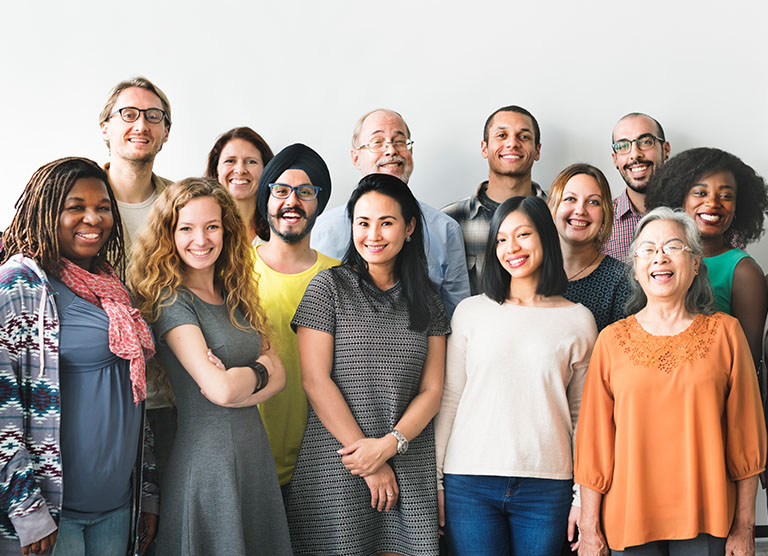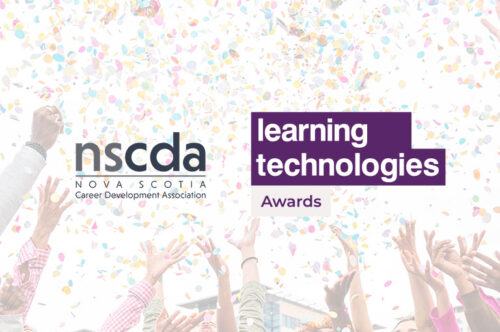Inclusive design in eLearning is good for everyone. Beyond new legislation creating a risk of legal action, organisations are recognising a simple fact: inaccessible training wastes money and limits the number of people they can reach.
Small text or poor colour contrast that strains the eye. Videos without captions. Navigation that confuses rather than guides. For people with disabilities, non-native speakers, neurodiverse learners or anyone with learning differences, these obstacles may prevent them from accessing your content entirely. But barriers such as these make it harder for everyone. This guide demonstrates how inclusive eLearning design creates better learning outcomes for everyone regardless of how the person might see, hear, interact with or process information.
What do we mean by inclusive learning?
Inclusive learning goes far beyond meeting the minimum legal requirements for accessibility. It ensures that learning is accessible by, relevant to and representative of all learners. Consider the diverse needs and backgrounds of any group of learners. Some may:
- Use screen readers or other adaptive technologies to navigate digital materials
- Access material in noisy environments or be in quite spaces where they can’t use audio
- Be non-native speakers navigating complex technical concepts
- Be neurodiverse and process information differently
- Have a physical disability or an injury that limits movement or dexterity
- Have a different set of cultural references and values
- Have varying levels of computer literacy, access to technology and internet connectivity
Inclusive learning does not just target one or some of these groups. Instead, it is designed to account for all of their needs.
How does inclusive design differ from accessible design?
Inclusivity differs from accessibility, though they are closely related. Web accessibility focuses on removing technical barriers so that everyone can perceive, understand, navigate and interact with digital content. It is governed by specific standards that define how content is technically built to be displayed in a web browser. Meeting these standards will involve correctly identifying page titles, structuring content with headings and subheadings, providing text alternatives for images and many other technical considerations.
Ensuring content is fully accessible is a key part of inclusive design, but inclusivity goes beyond technical considerations. It encompasses the full spectrum of human difference and recognises these differences as natural variations to be accommodated.
Inclusive design addresses wide-ranging areas, including:
- Disabilities, including cognitive and learning disabilities
- Neurodiversity
- Cognitive relevance and representation
- Diversity of language
- Socioeconomic factors and access to technology
Ensuring content is fully accessible is a key part of inclusive design but inclusivity goes beyond technical considerations

The curb cut effect
The ‘curb cut effect’ demonstrates how features which support one group often end up benefiting a much wider population. A curb cut is where the edge of a footpath has been lowered. They were designed so that wheelchair users could easily move on and off footpaths. But it quickly became clear they also helped parents with pushchairs, delivery workers with trolleys, travellers with suitcases and anyone who finds steps challenging.
In a similar way, design elements created to support one group often benefit many other groups. Closed captions on video content help Deaf learners but also benefit people in noisy environments, non-native speakers and those who prefer reading to listening. Or text written in Plain English benefits those with learning disabilities but also makes content clearer and more easy to read for all. Inclusive design in eLearning benefits everybody.
Legal requirements and standards
While inclusivity is broader than just meeting accessibility standards, it is important to meet those standards. Accessibility legislation varies by jurisdiction but it creates clear legal obligations for both public and private organisations. Understanding these requirements helps ensure compliance whilst protecting against legal risks.
Europe
For members of the European Union (EU), the European Accessibility Act (EAA), which came into effect in June 2025, requires public bodies and many private businesses to ensure their websites and digital services are accessible to all. eLearning falls under the Act as it is considered a digital service. eLearning providers outside the EU also need to comply with the Act if they want to sell to the within the EU.
In the UK, the Public Sector Bodies (Websites and Mobile Applications) Accessibility Regulations 2018 requires public sector bodies to make all content and services, including digital content, accessible to the widest possible audience. The Equality Act 2010 outlines various grounds on which discrimination is illegal and applies to both public and private organisations. While it doesn’t specifically mention digital services, it does apply to eLearning as it mandates that ‘provision of services’ must not discriminate.
North America
In the US, accessibility is primarily governed by the Americans with Disabilities Act 1990, which prohibits discrimination against people with disabilities. Courts interprete this to apply to websites and digital content as ‘places of public accommodation’.
In Canada, the Accessible Canda Act 2019 and a number of pieces of provincial legislation requires organisations to meet WCAG Level AA standards for websites and digital content. It aims for a barrier-free Canada by 2040.
Accessibility standards
The Web Content Accessibility Guidelines (WCAG) 2.2 provide the international standard for digital content accessibility. The guidelines outline three levels of compliance:
WCAG 2.2 A
This is the lowest level of compliance. eLearning built to this standard satisfies all the Level A success criteria, or a conforming alternate version is provided.
WCAG 2.2 AA
This is the mid-range level of compliance. eLearning built to this standard satisfies all the Level A and Level AA success criteria, or a Level AA conforming alternate version is provided.
WCAG 2.2 AAA
This is the highest level of compliance. eLearning built to this standard satisfies all the Level A, Level AA and Level AAA success criteria, or a Level AAA conforming alternate version is provided.
Making the case for inclusive design in eLearning
Inclusive design ensures that everyone has the same opportunities to benefit from eLearning. It creates a fairer and more equitable environment for all. But aside from that, inclusive design in eLearning has many advantages for both public and private organisations.
Pre-empting the need for accommodation
Inclusive design proves more efficient than reactive workplace accommodations. A universal design for learning approach builds accessibility into the foundation rather than adding it later. This proactive strategy saves time, resources and the frustration of retrofitting existing content. Organisations can avoid the significant resources associated with rebuilding learning materials to meet accessibility requirements after launch.
Enhanced reputation
Demonstrating a commitment to inclusivity can help organisations attract and retain talent more effectively in competitive job markets. Ensuring all training material is designed with inclusivity and accessibility in mind is an important part of a wider strategy of inclusivity.
Failure to make digital learning content inclusive can result in reputational damage, particularly for educational organisations and for organisations that serve the wider public.
Mitigating legal risk
In the US, there were 287 ADA accessibility lawsuits filed against businesses and educational institutions in January 2023 alone. While public bodies and educational institutes have traditionally been held to higher standards for accessibility and inclusivity, it’s now essential for all organisations, including private companies, to ensure they are complying with anti-discrimination laws or risk legal action.
Wider reach
When your organisation shows a genuine commitment to inclusivity, you open doors to more people. This means you can attract more students, clients, service users, customers or potential employees. By removing barriers, you help more people access your content and engage with your organisation.
A better learning experience
When learners can easily access and engage with content, learning outcomes improve significantly. Satisfaction rates increase. Completion rates rise. The learning experience becomes more effective for everyone involved, creating positive ripple effects throughout the organisation.
Improved performance
When employees can fully access and understand training, their job performance improves. They apply new skills more effectively. Error rates decrease. Confidence grows. Employees who learn successfully through inclusive training deliver better results, need less support and contribute more effectively to organisational goals.
How to design inclusive eLearning
Now that we’ve discussed what inclusive eLearning is and why it should be a core part of your eLearning strategy, let’s look at how we can design eLearning that is fully inclusive.
eLearning should be POUR: Perceivable, Operable, Understandable & Robust
Web content accessibility guidelines
As we mentioned, the Web Content Accessibility Guidelines (WCAG) 2.2 outline requirements for digital content accessibility, with WCAG 2.2 AA being the level of compliance usually required by accessibility legislation.
In order to meet these standards, eLearning must be designed in line with four fundamental principles — Perceivable, Operable, Understandable and Robust, commonly known as POUR:
- Perceivable: All information and user interface components in the eLearning course must be presented in ways that all users can perceive. This often involves presenting information in multiple ways. An image should also have a text alternative present in the form of alt text; a video should have closed captions; an audio clip should have a transcript and so on. This ensures that the same information is perceivable by all users, even if they access it in different ways.
- Operable: The interface must function for all users whether they’re using a mouse, keyboard or any other assistive technology to navigate. A key element of accessibility is ensuring that elements such as headings, lists or hyperlinks are structured with the correct HTML Markup so that tools such as screen readers can identify them.
- Understandable: The eLearning course must work predictably with error messages present if something does not work as expected. Clear, easy to follow instructions must be present to direct the user on what to do. Language used throughout should be as concise and written as simply as the subject allows for.
- Robust: The eLearning must be compatible across the range of different devices, browsers, and operating systems that learners may be using. It should reliably function with a range of different technologies and assistive devices.
Universal Design for Learning
Universal Design for Learning (UDL) is an expansion of the concept of Universal Design (UD). Originally a principle in architecture, UD proposed that all buildings and spaces be designed in such a way that they were usable by the widest possible array of people. Rather than designing something and then later adapting to facilitate people with disabilities, UD proposed designing in such a way that there were no barriers to begin with.
Universal Design for Learning takes a similar approach. Learning should be designed in a way that it is accessible from the beginning to the widest array of people possible. This will eliminate, or at least reduce the need for adaption for specific groups. It offers equal access to all, by design.
The UDL approach is based on three core principles that address different aspects of the learning experience. Each principle provides practical guidance for eLearning developers and instructional designers.
- Multiple means of engagement focuses on the ‘why’ of learning. This principle emphasises providing diverse ways to motivate learners, tap into their interests and keep their attention throughout the learning process. Practical applications include offering choices in how to approach learning tasks, making content relevant to learner experiences and minimising distractions that interfere with engagement. This can be particularly relevant when designing with neurodiversity or learning disabilities in mind.
- Multiple means of representation addresses the ‘what’ of learning. This principle acknowledges that learners perceive and process information differently. It emphasises the importance of presenting content through various channels and formats. Information should be accessible through different sensory modalities (visual, auditory and tactile) using text, audio, video and interactive media strategically. This principle particularly benefits learners with disabilities who may rely on screen readers, captions or alternative text formats. It also supports non-native speakers who benefit from visual supports and multiple presentation methods.
- Multiple means of action and expression concerns the ‘how’ of learning. This principle focuses on offering diverse options for learners to demonstrate their knowledge and skills. Rather than limiting assessment to traditional methods like written exams, UDL encourages projects, discussions, multimedia submissions and other alternatives that accommodate different capacities and preferences.
Rather than creating standard content and adding accommodations later, UDL builds flexibility and choice into the foundation of the learning experience.
UDL is an expansion of the concept of Universal Design
Design learning to be accessible from the start

Plain English
The purpose of Plain English is to make text content clear, concise and accessible to all. In a similar way to UDL, Plain English aims to make content understandable to the widest array of people possible, including those who:
- have learning or cognitive disabilities
- have literacy challenges
- are not native speakers
But as we saw with the curb cut effect, making content inclusive benefits everybody. We all benefit from content that is written in a concise and jargon-free manner, particularly when it is technical or legal content.
Compare these two instructions:
- In order to pass this 10 question assessment, 8 out of the 10 must be answered correctly. Should you fail to answer 8 questions correctly, you must return to the start of this course and revise the content relevant to the questions which you failed.
- There are 10 questions in this assessment. You must answer 8 questions correctly to pass. If you fail the assessment, go back to the start of the course and revise the relevant content.
Both sets of instructions give the same information but the second is immediately more readable. Plain English prioritises simple sentence structure, common vocabulary over technical jargon, logical content organisation and using the active voice. Plain English doesn’t mean oversimplifying content but rather communicating complex ideas in the simplest language possible while still being appropriate to the subject matter and audience.
Representation and relevance
Creating inclusive learning experiences means ensuring that learners feel represented and that materials are relevant to their needs and experiences. Representation means actively including diverse perspectives, examples and scenarios that reflect the full spectrum of human experience.
...where learners feel represented, materials are relevant to their needs and experiences...
Diverse content
Content should include diverse names, backgrounds, family structures and life experiences that mirror the real diversity of your audience. Rather than defaulting to generic examples that may exclude certain groups, inclusive content deliberately incorporates varied perspectives.
Visual representation
Visual representation matters. Images, illustrations and videos should reflect diversity including race, ethnicity, age, ability, family structures and socioeconomic backgrounds. Avoid stock photography that supports stereotypes or limits representation. Instead, choose visuals that normalise and embrace diversity whilst supporting learning objectives.
Diverse characters and case studies
Case studies and scenarios provide powerful opportunities for inclusive representation. Rather than repeatedly using similar character profiles or business contexts, vary examples to include different industries, geographical locations, cultural perspectives and personal circumstances.
Inclusive language
Language choices contribute to representation. Use inclusive language that doesn’t assume specific family structures, cultural practices or life experiences. Avoid idioms, cultural references or examples that exclude international learners or those from different backgrounds. This consideration extends to assumptions about whether someone has a disability, their technology access, work arrangements or educational backgrounds.
Diverse sources
Consider the expertise and perspectives included in course materials. Whose voices are represented as experts? What research and insights are cited? What experiences are considered authoritative? Inclusive content draws from diverse sources and acknowledges different ways of knowing and understanding topics.

Inclusive learning experts
Partner with us
The Learning Rooms specialises in creating engaging, accessible and inclusive eLearning experiences. Our team of instructional designers and accessibility experts can partner with you to audit your existing content, develop new courses, train your team on best practices and establish sustainable inclusive design processes.
Whether you’re just getting started with designing inclusive eLearning or looking to enhance your current capabilities, we’re here to help you create learning experiences that truly work for everyone. Contact us to discover how we can support your commitment to inclusive eLearning.








